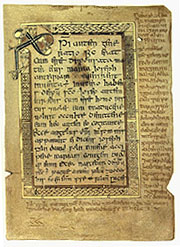|
which interpreted is:
"Colbin, mormaer (Pictish word for Earl) of Buchan, and Eva,
daughter of Gartnat, his wedded wife, and Donnachac, son of Sithec, toisech
of Clann Morgainn, immolated all the offerings to God and to Drostan and to
Columcille and to Peter the Apostle from all the burthens for a share of
four davochs of what would come on the chief residences (monasteries) of
Alba (Scotland) generally and on chief churches. Testibus his Broccin, and
Cormac, Abbot of Turbruaid (Turriff), and Morgunn, son of Donnchad (Duncan),
and Gille Petair, son of Donnchad (Duncan), and Malaechin and Matne's two
sons, and the nobles of Buchan, all in witness hereof in Elan (Ellon)".
The act of making this grant took place at Ellon, which was of old
the capital of the province and earldom of Buchan in Pictish times, at a
meeting of the officials, and "good men" or proprietors of the district.
This was doubtless held on the Moothill, a green mound at Ellon on the banks
of the River Ythan, where the Earls of Buchan administered justice and took
investiture of their great fief.
My thanks to Firths
Celtic Scotland for the use of the images and the translation of text.
By John A. Duncan of Sketraw, KCN, FSA
Scot. |
|

